BSBCUS501: Report on Strategies for Quality Customer Service
VerifiedAdded on 2023/06/11
|5
|1686
|375
Report
AI Summary
This report provides an analysis of strategies for managing and improving quality customer service, specifically focusing on Qantas airline. It explores the use of real-time systems and data science to monitor customer needs and expectations. The report also discusses resource management strategies, including planning, systematic approaches, and technology utilization, to enhance employee performance. Furthermore, it emphasizes the importance of customer feedback and various methods for gathering and analyzing it, such as weekly meetings, email analysis, and customer questionnaires. The report suggests using gap analysis to identify and address discrepancies between customer expectations and service delivery. Finally, it highlights the use of management information systems for data storage, security, and decision-making, emphasizing the critical role of data in predicting and shaping the company's future. Desklib offers this and many other solved assignments for students.
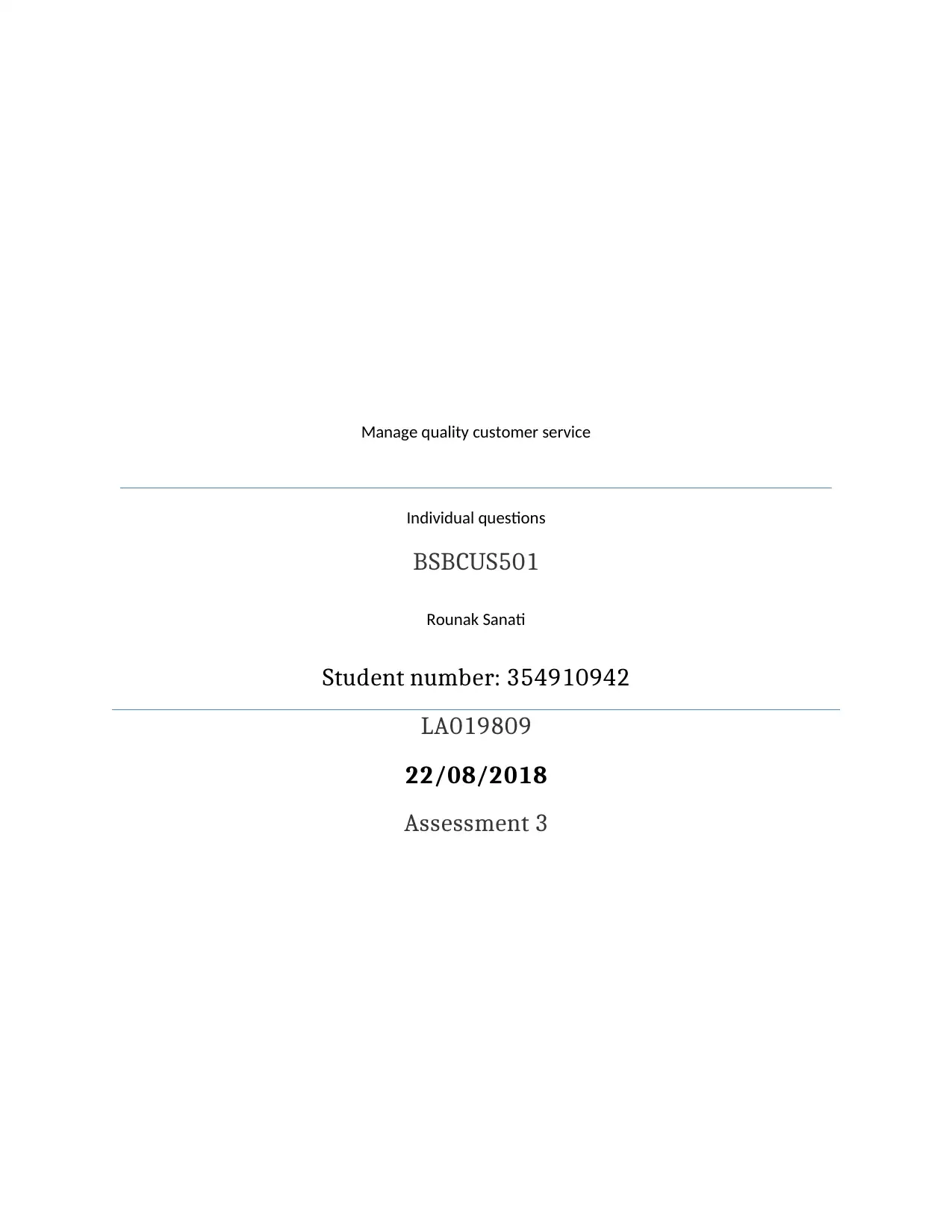
Manage quality customer service
Individual questions
BSBCUS501
Rounak Sanati
Student number: 354910942
LA019809
22/08/2018
Assessment 3
Individual questions
BSBCUS501
Rounak Sanati
Student number: 354910942
LA019809
22/08/2018
Assessment 3
Paraphrase This Document
Need a fresh take? Get an instant paraphrase of this document with our AI Paraphraser
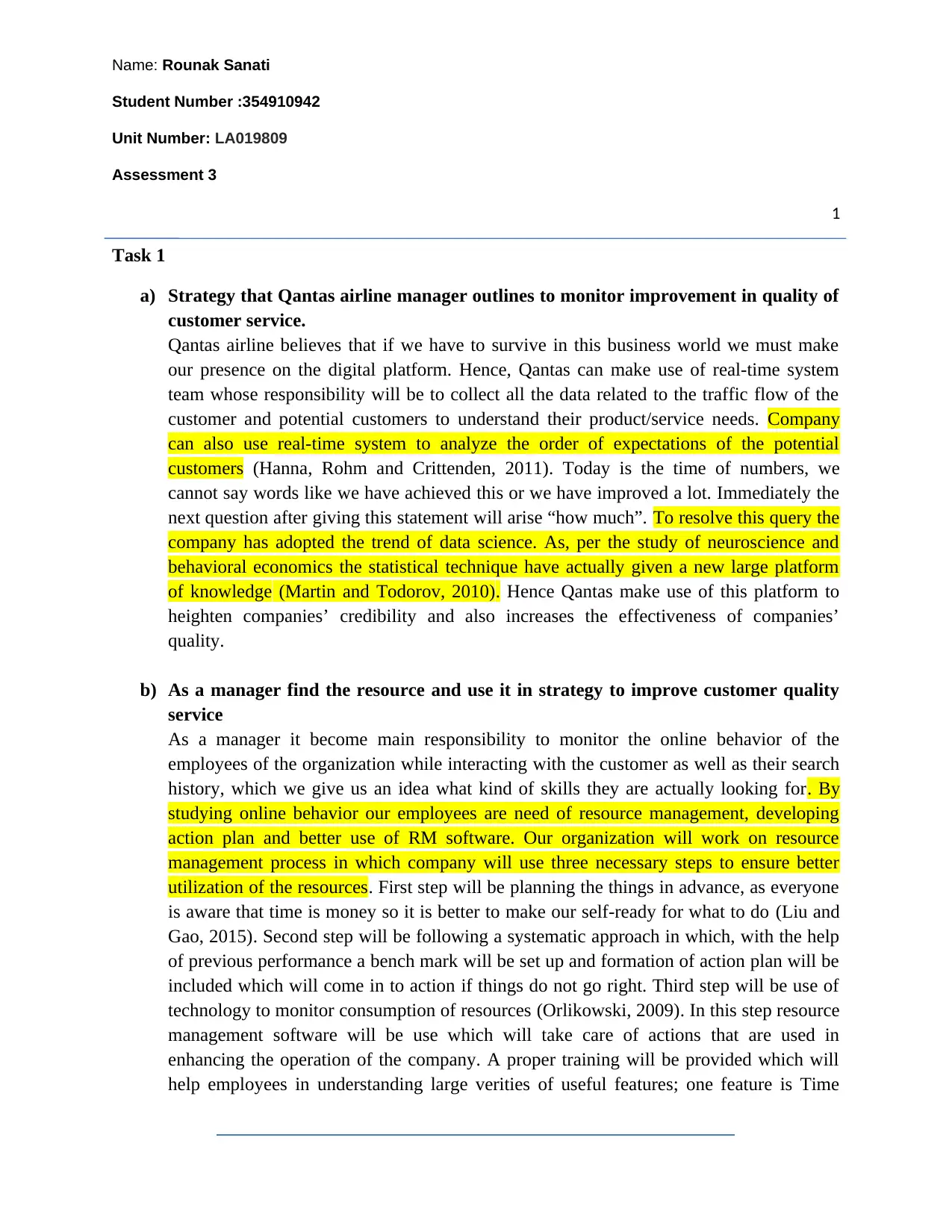
Name: Rounak Sanati
Student Number :354910942
Unit Number: LA019809
Assessment 3
1
Task 1
a) Strategy that Qantas airline manager outlines to monitor improvement in quality of
customer service.
Qantas airline believes that if we have to survive in this business world we must make
our presence on the digital platform. Hence, Qantas can make use of real-time system
team whose responsibility will be to collect all the data related to the traffic flow of the
customer and potential customers to understand their product/service needs. Company
can also use real-time system to analyze the order of expectations of the potential
customers (Hanna, Rohm and Crittenden, 2011). Today is the time of numbers, we
cannot say words like we have achieved this or we have improved a lot. Immediately the
next question after giving this statement will arise “how much”. To resolve this query the
company has adopted the trend of data science. As, per the study of neuroscience and
behavioral economics the statistical technique have actually given a new large platform
of knowledge (Martin and Todorov, 2010). Hence Qantas make use of this platform to
heighten companies’ credibility and also increases the effectiveness of companies’
quality.
b) As a manager find the resource and use it in strategy to improve customer quality
service
As a manager it become main responsibility to monitor the online behavior of the
employees of the organization while interacting with the customer as well as their search
history, which we give us an idea what kind of skills they are actually looking for. By
studying online behavior our employees are need of resource management, developing
action plan and better use of RM software. Our organization will work on resource
management process in which company will use three necessary steps to ensure better
utilization of the resources. First step will be planning the things in advance, as everyone
is aware that time is money so it is better to make our self-ready for what to do (Liu and
Gao, 2015). Second step will be following a systematic approach in which, with the help
of previous performance a bench mark will be set up and formation of action plan will be
included which will come in to action if things do not go right. Third step will be use of
technology to monitor consumption of resources (Orlikowski, 2009). In this step resource
management software will be use which will take care of actions that are used in
enhancing the operation of the company. A proper training will be provided which will
help employees in understanding large verities of useful features; one feature is Time
Student Number :354910942
Unit Number: LA019809
Assessment 3
1
Task 1
a) Strategy that Qantas airline manager outlines to monitor improvement in quality of
customer service.
Qantas airline believes that if we have to survive in this business world we must make
our presence on the digital platform. Hence, Qantas can make use of real-time system
team whose responsibility will be to collect all the data related to the traffic flow of the
customer and potential customers to understand their product/service needs. Company
can also use real-time system to analyze the order of expectations of the potential
customers (Hanna, Rohm and Crittenden, 2011). Today is the time of numbers, we
cannot say words like we have achieved this or we have improved a lot. Immediately the
next question after giving this statement will arise “how much”. To resolve this query the
company has adopted the trend of data science. As, per the study of neuroscience and
behavioral economics the statistical technique have actually given a new large platform
of knowledge (Martin and Todorov, 2010). Hence Qantas make use of this platform to
heighten companies’ credibility and also increases the effectiveness of companies’
quality.
b) As a manager find the resource and use it in strategy to improve customer quality
service
As a manager it become main responsibility to monitor the online behavior of the
employees of the organization while interacting with the customer as well as their search
history, which we give us an idea what kind of skills they are actually looking for. By
studying online behavior our employees are need of resource management, developing
action plan and better use of RM software. Our organization will work on resource
management process in which company will use three necessary steps to ensure better
utilization of the resources. First step will be planning the things in advance, as everyone
is aware that time is money so it is better to make our self-ready for what to do (Liu and
Gao, 2015). Second step will be following a systematic approach in which, with the help
of previous performance a bench mark will be set up and formation of action plan will be
included which will come in to action if things do not go right. Third step will be use of
technology to monitor consumption of resources (Orlikowski, 2009). In this step resource
management software will be use which will take care of actions that are used in
enhancing the operation of the company. A proper training will be provided which will
help employees in understanding large verities of useful features; one feature is Time
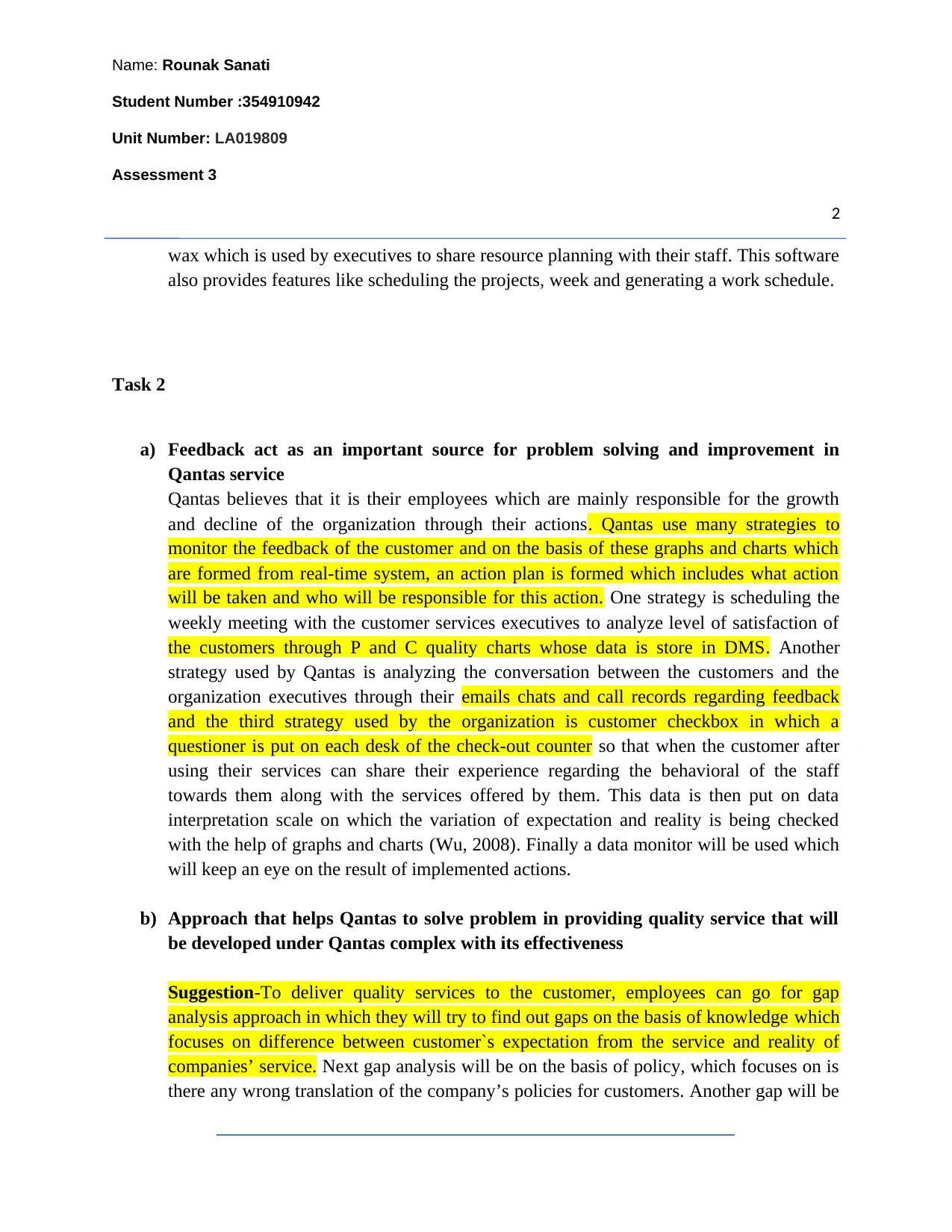
Name: Rounak Sanati
Student Number :354910942
Unit Number: LA019809
Assessment 3
2
wax which is used by executives to share resource planning with their staff. This software
also provides features like scheduling the projects, week and generating a work schedule.
Task 2
a) Feedback act as an important source for problem solving and improvement in
Qantas service
Qantas believes that it is their employees which are mainly responsible for the growth
and decline of the organization through their actions. Qantas use many strategies to
monitor the feedback of the customer and on the basis of these graphs and charts which
are formed from real-time system, an action plan is formed which includes what action
will be taken and who will be responsible for this action. One strategy is scheduling the
weekly meeting with the customer services executives to analyze level of satisfaction of
the customers through P and C quality charts whose data is store in DMS. Another
strategy used by Qantas is analyzing the conversation between the customers and the
organization executives through their emails chats and call records regarding feedback
and the third strategy used by the organization is customer checkbox in which a
questioner is put on each desk of the check-out counter so that when the customer after
using their services can share their experience regarding the behavioral of the staff
towards them along with the services offered by them. This data is then put on data
interpretation scale on which the variation of expectation and reality is being checked
with the help of graphs and charts (Wu, 2008). Finally a data monitor will be used which
will keep an eye on the result of implemented actions.
b) Approach that helps Qantas to solve problem in providing quality service that will
be developed under Qantas complex with its effectiveness
Suggestion-To deliver quality services to the customer, employees can go for gap
analysis approach in which they will try to find out gaps on the basis of knowledge which
focuses on difference between customer`s expectation from the service and reality of
companies’ service. Next gap analysis will be on the basis of policy, which focuses on is
there any wrong translation of the company’s policies for customers. Another gap will be
Student Number :354910942
Unit Number: LA019809
Assessment 3
2
wax which is used by executives to share resource planning with their staff. This software
also provides features like scheduling the projects, week and generating a work schedule.
Task 2
a) Feedback act as an important source for problem solving and improvement in
Qantas service
Qantas believes that it is their employees which are mainly responsible for the growth
and decline of the organization through their actions. Qantas use many strategies to
monitor the feedback of the customer and on the basis of these graphs and charts which
are formed from real-time system, an action plan is formed which includes what action
will be taken and who will be responsible for this action. One strategy is scheduling the
weekly meeting with the customer services executives to analyze level of satisfaction of
the customers through P and C quality charts whose data is store in DMS. Another
strategy used by Qantas is analyzing the conversation between the customers and the
organization executives through their emails chats and call records regarding feedback
and the third strategy used by the organization is customer checkbox in which a
questioner is put on each desk of the check-out counter so that when the customer after
using their services can share their experience regarding the behavioral of the staff
towards them along with the services offered by them. This data is then put on data
interpretation scale on which the variation of expectation and reality is being checked
with the help of graphs and charts (Wu, 2008). Finally a data monitor will be used which
will keep an eye on the result of implemented actions.
b) Approach that helps Qantas to solve problem in providing quality service that will
be developed under Qantas complex with its effectiveness
Suggestion-To deliver quality services to the customer, employees can go for gap
analysis approach in which they will try to find out gaps on the basis of knowledge which
focuses on difference between customer`s expectation from the service and reality of
companies’ service. Next gap analysis will be on the basis of policy, which focuses on is
there any wrong translation of the company’s policies for customers. Another gap will be
⊘ This is a preview!⊘
Do you want full access?
Subscribe today to unlock all pages.

Trusted by 1+ million students worldwide
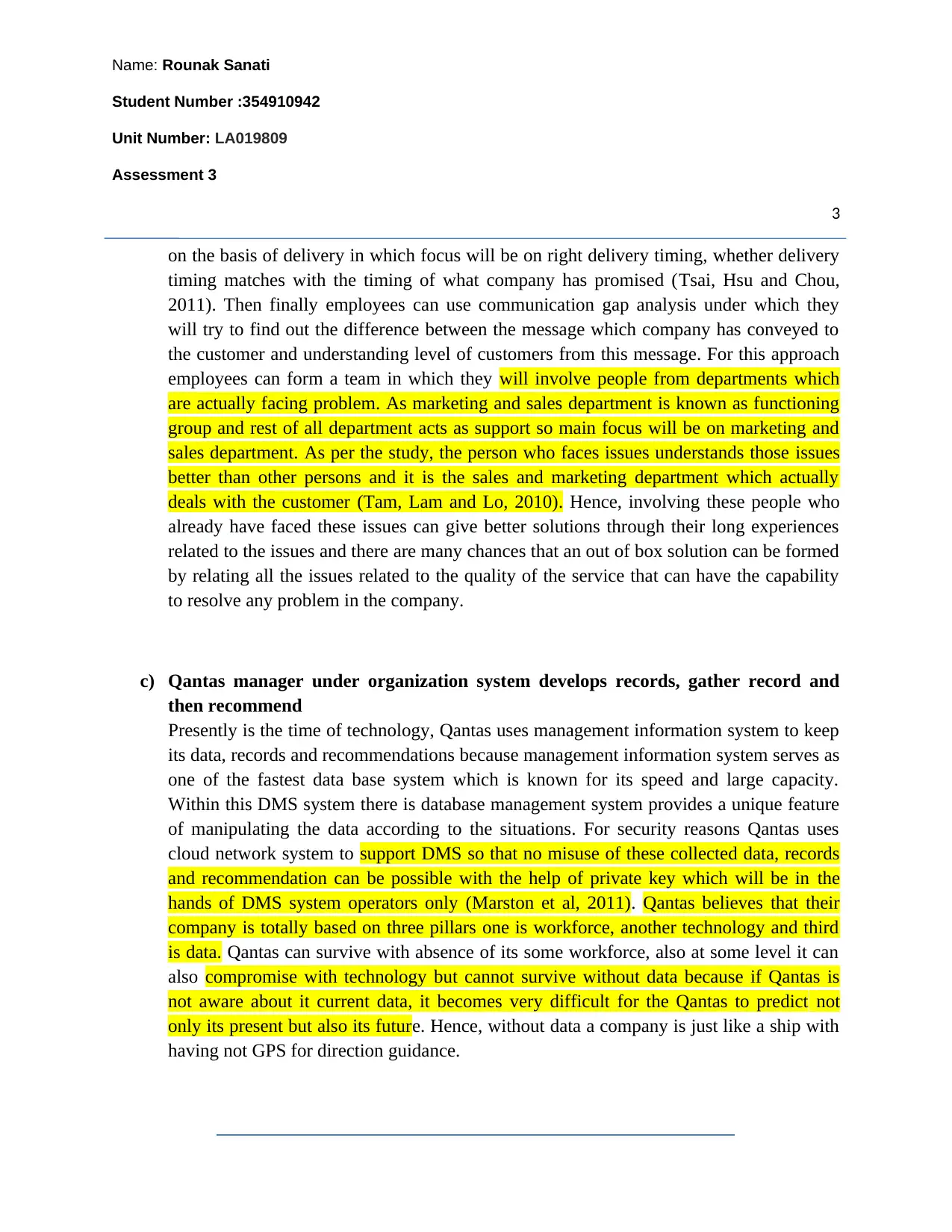
Name: Rounak Sanati
Student Number :354910942
Unit Number: LA019809
Assessment 3
3
on the basis of delivery in which focus will be on right delivery timing, whether delivery
timing matches with the timing of what company has promised (Tsai, Hsu and Chou,
2011). Then finally employees can use communication gap analysis under which they
will try to find out the difference between the message which company has conveyed to
the customer and understanding level of customers from this message. For this approach
employees can form a team in which they will involve people from departments which
are actually facing problem. As marketing and sales department is known as functioning
group and rest of all department acts as support so main focus will be on marketing and
sales department. As per the study, the person who faces issues understands those issues
better than other persons and it is the sales and marketing department which actually
deals with the customer (Tam, Lam and Lo, 2010). Hence, involving these people who
already have faced these issues can give better solutions through their long experiences
related to the issues and there are many chances that an out of box solution can be formed
by relating all the issues related to the quality of the service that can have the capability
to resolve any problem in the company.
c) Qantas manager under organization system develops records, gather record and
then recommend
Presently is the time of technology, Qantas uses management information system to keep
its data, records and recommendations because management information system serves as
one of the fastest data base system which is known for its speed and large capacity.
Within this DMS system there is database management system provides a unique feature
of manipulating the data according to the situations. For security reasons Qantas uses
cloud network system to support DMS so that no misuse of these collected data, records
and recommendation can be possible with the help of private key which will be in the
hands of DMS system operators only (Marston et al, 2011). Qantas believes that their
company is totally based on three pillars one is workforce, another technology and third
is data. Qantas can survive with absence of its some workforce, also at some level it can
also compromise with technology but cannot survive without data because if Qantas is
not aware about it current data, it becomes very difficult for the Qantas to predict not
only its present but also its future. Hence, without data a company is just like a ship with
having not GPS for direction guidance.
Student Number :354910942
Unit Number: LA019809
Assessment 3
3
on the basis of delivery in which focus will be on right delivery timing, whether delivery
timing matches with the timing of what company has promised (Tsai, Hsu and Chou,
2011). Then finally employees can use communication gap analysis under which they
will try to find out the difference between the message which company has conveyed to
the customer and understanding level of customers from this message. For this approach
employees can form a team in which they will involve people from departments which
are actually facing problem. As marketing and sales department is known as functioning
group and rest of all department acts as support so main focus will be on marketing and
sales department. As per the study, the person who faces issues understands those issues
better than other persons and it is the sales and marketing department which actually
deals with the customer (Tam, Lam and Lo, 2010). Hence, involving these people who
already have faced these issues can give better solutions through their long experiences
related to the issues and there are many chances that an out of box solution can be formed
by relating all the issues related to the quality of the service that can have the capability
to resolve any problem in the company.
c) Qantas manager under organization system develops records, gather record and
then recommend
Presently is the time of technology, Qantas uses management information system to keep
its data, records and recommendations because management information system serves as
one of the fastest data base system which is known for its speed and large capacity.
Within this DMS system there is database management system provides a unique feature
of manipulating the data according to the situations. For security reasons Qantas uses
cloud network system to support DMS so that no misuse of these collected data, records
and recommendation can be possible with the help of private key which will be in the
hands of DMS system operators only (Marston et al, 2011). Qantas believes that their
company is totally based on three pillars one is workforce, another technology and third
is data. Qantas can survive with absence of its some workforce, also at some level it can
also compromise with technology but cannot survive without data because if Qantas is
not aware about it current data, it becomes very difficult for the Qantas to predict not
only its present but also its future. Hence, without data a company is just like a ship with
having not GPS for direction guidance.
Paraphrase This Document
Need a fresh take? Get an instant paraphrase of this document with our AI Paraphraser
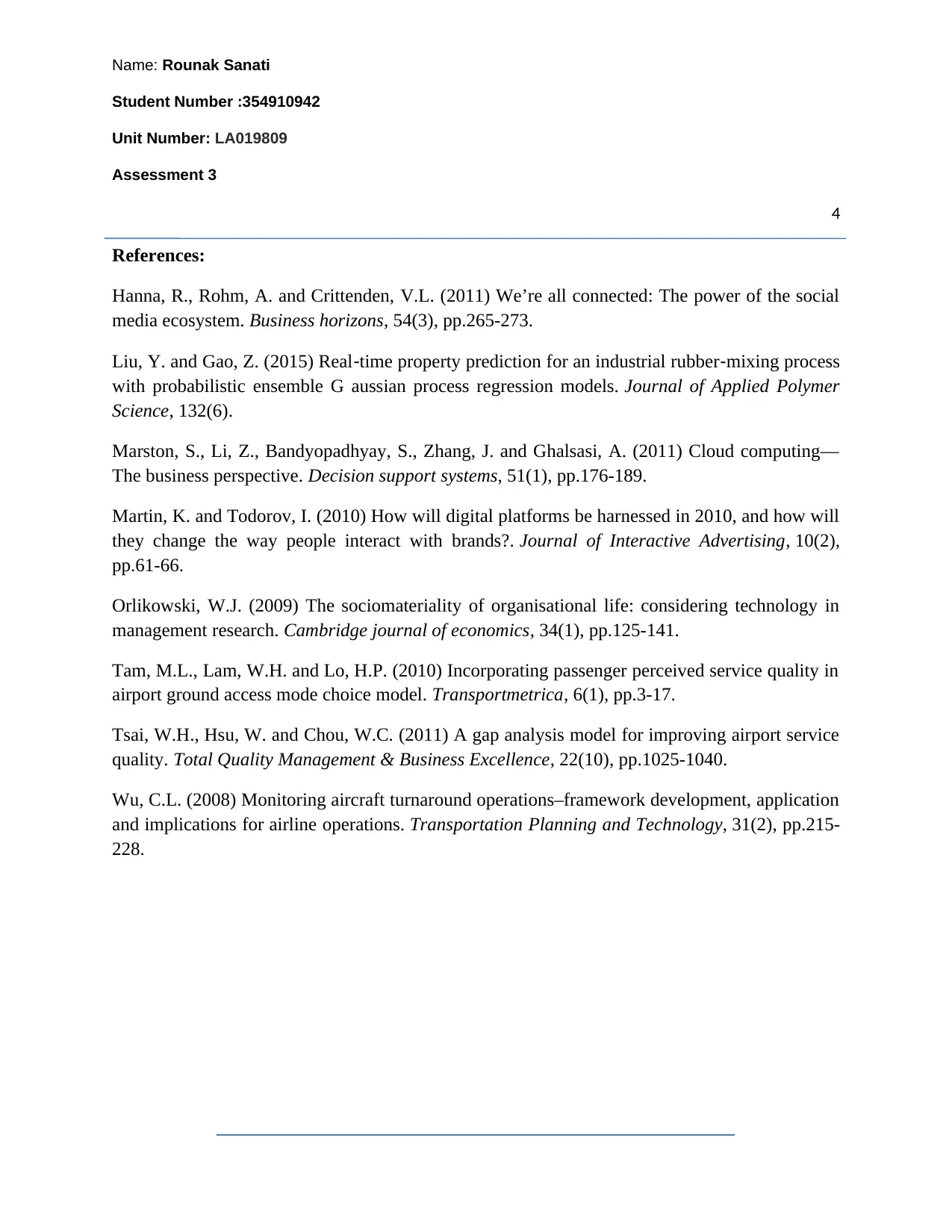
Name: Rounak Sanati
Student Number :354910942
Unit Number: LA019809
Assessment 3
4
References:
Hanna, R., Rohm, A. and Crittenden, V.L. (2011) We’re all connected: The power of the social
media ecosystem. Business horizons, 54(3), pp.265-273.
Liu, Y. and Gao, Z. (2015) Real‐time property prediction for an industrial rubber‐mixing process
with probabilistic ensemble G aussian process regression models. Journal of Applied Polymer
Science, 132(6).
Marston, S., Li, Z., Bandyopadhyay, S., Zhang, J. and Ghalsasi, A. (2011) Cloud computing—
The business perspective. Decision support systems, 51(1), pp.176-189.
Martin, K. and Todorov, I. (2010) How will digital platforms be harnessed in 2010, and how will
they change the way people interact with brands?. Journal of Interactive Advertising, 10(2),
pp.61-66.
Orlikowski, W.J. (2009) The sociomateriality of organisational life: considering technology in
management research. Cambridge journal of economics, 34(1), pp.125-141.
Tam, M.L., Lam, W.H. and Lo, H.P. (2010) Incorporating passenger perceived service quality in
airport ground access mode choice model. Transportmetrica, 6(1), pp.3-17.
Tsai, W.H., Hsu, W. and Chou, W.C. (2011) A gap analysis model for improving airport service
quality. Total Quality Management & Business Excellence, 22(10), pp.1025-1040.
Wu, C.L. (2008) Monitoring aircraft turnaround operations–framework development, application
and implications for airline operations. Transportation Planning and Technology, 31(2), pp.215-
228.
Student Number :354910942
Unit Number: LA019809
Assessment 3
4
References:
Hanna, R., Rohm, A. and Crittenden, V.L. (2011) We’re all connected: The power of the social
media ecosystem. Business horizons, 54(3), pp.265-273.
Liu, Y. and Gao, Z. (2015) Real‐time property prediction for an industrial rubber‐mixing process
with probabilistic ensemble G aussian process regression models. Journal of Applied Polymer
Science, 132(6).
Marston, S., Li, Z., Bandyopadhyay, S., Zhang, J. and Ghalsasi, A. (2011) Cloud computing—
The business perspective. Decision support systems, 51(1), pp.176-189.
Martin, K. and Todorov, I. (2010) How will digital platforms be harnessed in 2010, and how will
they change the way people interact with brands?. Journal of Interactive Advertising, 10(2),
pp.61-66.
Orlikowski, W.J. (2009) The sociomateriality of organisational life: considering technology in
management research. Cambridge journal of economics, 34(1), pp.125-141.
Tam, M.L., Lam, W.H. and Lo, H.P. (2010) Incorporating passenger perceived service quality in
airport ground access mode choice model. Transportmetrica, 6(1), pp.3-17.
Tsai, W.H., Hsu, W. and Chou, W.C. (2011) A gap analysis model for improving airport service
quality. Total Quality Management & Business Excellence, 22(10), pp.1025-1040.
Wu, C.L. (2008) Monitoring aircraft turnaround operations–framework development, application
and implications for airline operations. Transportation Planning and Technology, 31(2), pp.215-
228.
1 out of 5
Related Documents
Your All-in-One AI-Powered Toolkit for Academic Success.
+13062052269
info@desklib.com
Available 24*7 on WhatsApp / Email
![[object Object]](/_next/static/media/star-bottom.7253800d.svg)
Unlock your academic potential
Copyright © 2020–2025 A2Z Services. All Rights Reserved. Developed and managed by ZUCOL.





